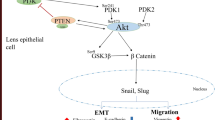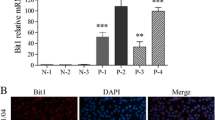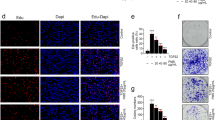Abstract
Background
Posterior capsule opacification (PCO) represents a major challenge in the postoperative management of cataract patients. Spreading, migration and contraction of residual human lens epithelial cells play a pivotal role in the pathogenesis of PCO. Therefore, we analyzed the effect of the alkylphosphocholine (APC) erufosine on these cellular features as well as on PI3K/Akt, a crucial pathway in PCO pathogenesis.
Methods
Human lens epithelial cells were cultured under standard cell culture conditions. Cell spreading was analyzed on fibronectin-coated wells and chemokinetic migration was assessed by time-lapse microscopy. For evaluation of cell-mediated collagen matrix contraction, the cells were seeded into collagen gels and incubated with an APC in different non-toxic concentrations before the surface area was measured on day 6. The activity of PI3K/Akt was assessed by an ELISA kit after incubation of the cells with different APC concentrations.
Results
Human lens epithelial cell spreading and migration were attenuated by APCs as follows: 7 % spreading, 48 % migration (0.1 μM APC), and 32 % spreading, 68 % migration (1.0 μM APC). APC concentrations of 0.1 μM reduced collagen gel diameter by 5 %, and 1.0 μM by less than 1 %, compared to untreated, cell-populated gels that resulted in a cell diameter contraction of 36 %. PI3K was downregulated in a concentration-dependent manner.
Conclusions
The crucial cellular features of PCO pathogenesis are attenuated by the APC erufosine via downregulation of the PI3K pathway. Thus, erufosine might become a valuable tool for pharmacologic PCO prophylaxis in the future.





Similar content being viewed by others
References
Apple DJ, Solomon KD, Tetz MR, Assia EI, Holland EY, Legler UF, Tsai JC, Castaneda VE, Hoggatt JP, Kostick AM (1992) Posterior capsule opacification. Surv Ophthalmol 37:73–116
Wormstone IM, Wang L, Liu CS (2009) Posterior capsule opacification. Exp Eye Res 88:257–269. doi:10.1016/j.exer.2008.10.016
Kramer S, Schroder AC, Bruckner K, Jonescu-Cuypers C, Seitz B (2010) Subluxation of hydrophilic acrylate intraocular lenses due to massive capsular fibrosis. Der Ophthalmologe: Zeitschrift der Deutschen Ophthalmologischen Gesellschaft 107:460–464. doi:10.1007/s00347-009-2025-y
Vrijman V, van der Linden JW, Nieuwendaal CP, van der Meulen IJ, Mourits MP, Lapid-Gortzak R (2012) Effect of Nd:YAG laser capsulotomy on refraction in multifocal apodized diffractive pseudophakia. J Refract Surg (Thorofare, NJ: 1995) 28:545–550. doi:10.3928/1081597x-20120723-03
Qatarneh D, Hau S, Tuft S (2010) Hyperopic shift from posterior migration of hydrophilic acrylic intraocular lens optic. J Cataract Refract Surg 36:161–163. doi:10.1016/j.jcrs.2009.06.042
Zaugg B, Werner L, Neuhann T, Burrow M, Davis D, Mamalis N, Tetz M (2010) Clinicopathologic correlation of capsulorhexis phimosis with anterior flexing of single-piece hydrophilic acrylic intraocular lens haptics. J Cataract Refract Surg 36:1605–1609. doi:10.1016/j.jcrs.2010.06.029
Apple DJ, Peng Q, Visessook N, Werner L, Pandey SK, Escobar-Gomez M, Ram J, Auffarth GU (2001) Eradication of posterior capsule opacification: documentation of a marked decrease in Nd:YAG laser posterior capsulotomy rates noted in an analysis of 5416 pseudophakic human eyes obtained postmortem. Ophthalmology 108:505–518
Vardarinos A, Empeslidis T, Periysamy K, Menassa N, Shahid F, Uppal S, Deane J (2012) Tear of Retinal Pigment Epithelium following YAG Laser Posterior Capsulotomy in a Patient on Anti-VEGF Treatment for AMD: Six Months’ Follow-Up. Case Reports Ophthalmol 3:221–225. doi:10.1159/000339856
Ho JC, Yuen NS, Chan CW (2012) Capsule membrane growth complicating glaucoma and corneal decompensation after neodymium:YAG capsulotomy. J Cataract Refract Surg 38:1492–1494. doi:10.1016/j.jcrs.2012.06.029
Awasthi N, Guo S, Wagner BJ (2009) Posterior capsular opacification: a problem reduced but not yet eradicated. Archives Ophthalmol 127:555–562. doi:10.1001/archophthalmol.2009.3
Findl O, Buehl W, Bauer P, Sycha T (2010) Interventions for preventing posterior capsule opacification. Cochrane database of systematic reviews (Online): CD003738 doi 10.1002/14651858.CD003738.pub3
Jiang Q, Zhou C, Bi Z, Wan Y (2006) EGF-induced cell migration is mediated by ERK and PI3K/AKT pathways in cultured human lens epithelial cells. J Ocular Pharmacol Therapeutics: Off J Assoc Ocular Pharmacol Ther 22:93–102. doi:10.1089/jop.2006.22.93
Mansfield KJ, Cerra A, Chamberlain CG (2004) FGF-2 counteracts loss of TGFbeta affected cells from rat lens explants: implications for PCO (after cataract). Molecular Vision 10:521–532
Xiong W, Cheng BH, Jia SB, Tang LS (2010) Involvement of the PI3K/Akt signaling pathway in platelet-derived growth factor-induced migration of human lens epithelial cells. Curr Eye Res 35:389–401. doi:10.3109/02713680903584686
Yao K, Ye PP, Tan J, Tang XJ, Shen Tu XC (2008) Involvement of PI3K/Akt pathway in TGF-beta2-mediated epithelial mesenchymal transition in human lens epithelial cells. Ophthalmic Res 40:69–76. doi:10.1159/000113884
Choi J, Park SY, Joo CK (2004) Hepatocyte growth factor induces proliferation of lens epithelial cells through activation of ERK1/2 and JNK/SAPK. Investig Ophthalmol Vis Sci 45:2696–2704. doi:10.1167/iovs.03-1371
Eibl KH, Liegl R, Kernt M, Priglinger S, Kampik A (2009) Alkylphosphocholines as a potential pharmacologic prophylaxis for posterior capsule opacification. J Cataract Refract Surg 35:900–905. doi:10.1016/j.jcrs.2008.11.064
Liegl R, Kernt M, Obholzer K, Wolf A, Schumann R, Haritoglou C, Kampik A, Eibl-Lindner KH (2010) Alkylphosphocholines inhibit lens epithelial cell proliferation and attachment. Der Ophthalmologe: Zeitschrift der Deutschen Ophthalmologischen Gesellschaft 107:937–940. doi:10.1007/s00347-010-2128-5
Ruiter GA, Zerp SF, Bartelink H, van Blitterswijk WJ, Verheij M (2003) Anti-cancer alkyl-lysophospholipids inhibit the phosphatidylinositol 3-kinase-Akt/PKB survival pathway. Anti-Cancer Drugs 14:167–173. doi:10.1097/01.cad.0000054974.31252.f7
Bagley RG, Kurtzberg L, Rouleau C, Yao M, Teicher BA (2011) Erufosine, an alkylphosphocholine, with differential toxicity to human cancer cells and bone marrow cells. Cancer Chemother Pharmacol 68:1537–1546. doi:10.1007/s00280-011-1658-0
Eibl KH, Banas B, Schoenfeld CL, May CA, Neubauer AS, Priglinger S, Kampik A, Welge-Lussen U (2003) Alkylphosphocholines inhibit proliferation of human retinal pigment epithelial cells. Investig Ophthalmol Vis Sci 44:3556–3561
Schuettauf F, Eibl KH, Thaler S, Shinoda K, Rejdak R, May CA, Blatsios G, Welge-Lussen U (2005) Toxicity study of erucylphosphocholine in a rat model. Curr Eye Res 30:813–820. doi:10.1080/02713680591006093
Eibl KH, Schwabe K, Welge-Luessen U, Kampik A, Eichler W (2008) The role of alkylphosphocholines in retinal Muller glial cell proliferation. Curr Eye Res 33:385–393. doi:10.1080/02713680801956460
Luke M, Januschowski K, Luke J, Grisanti S, Szurman P, Dietz K, Kampik A, Bartz-Schmidt KU, Eibl-Lindner KH (2010) The safety profile of alkylphosphocholines in the model of the isolated perfused vertebrate retina. Graefe‘s Arch Clin Exp Ophthalmol Albrecht von Graefes Archiv fur klinische und experimentelle Ophthalmologie 248:511–518. doi:10.1007/s00417-009-1246-8
Eibl KH, Banas B, Kook D, Ohlmann AV, Priglinger S, Kampik A, Welge-Luessen UC (2004) Alkylphosphocholines: a new therapeutic option in glaucoma filtration surgery. Investig Ophthalmol Vis Sci 45:2619–2624. doi:10.1167/iovs.03-1351
Li J, Tang X, Chen X (2011) Comparative effects of TGF-beta2/Smad2 and TGF-beta2/Smad3 signaling pathways on proliferation, migration, and extracellular matrix production in a human lens cell line. Exp Eye Res 92:173–179. doi:10.1016/j.exer.2011.01.009
Wang Y, Lou MF (2009) The regulation of NADPH oxidase and its association with cell proliferation in human lens epithelial cells. Investig Ophthalmol Vis Sci 50:2291–2300. doi:10.1167/iovs.08-2568
Andley UP, Malone JP, Townsend RR (2011) Inhibition of lens photodamage by UV-absorbing contact lenses. Investig Ophthalmol Vis Sci 52:8330–8341. doi:10.1167/iovs.11-7633
van Blitterswijk WJ, Verheij M (2013) Anticancer mechanisms and clinical application of alkylphospholipids. Biochimica et Biophysica Acta 1831:663–674. doi:10.1016/j.bbalip.2012.10.008
Saller MM, Prall WC, Docheva D, Schonitzer V, Popov T, Anz D, Clausen-Schaumann H, Mutschler W, Volkmer E, Schieker M, Polzer H (2012) Increased stemness and migration of human mesenchymal stem cells in hypoxia is associated with altered integrin expression. Biochem Biophys Res Commun 423:379–385. doi:10.1016/j.bbrc.2012.05.134
Mazure A, Grierson I (1992) In vitro studies of the contractility of cell types involved in proliferative vitreoretinopathy. Investig Ophthalmol Vis Sci 33:3407–3416
Wormstone IM, Collison DJ, Hansom SP, Duncan G (2006) A focus on the human lens in vitro. Environ Toxicol Pharmacol 21:215–221. doi:10.1016/j.etap.2005.07.012
Nebe B, Kunz F, Peters A, Rychly J, Noack T, Beck R (2004) Induction of apoptosis by the calcium antagonist mibefradil correlates with depolarization of the membrane potential and decreased integrin expression in human lens epithelial cells. Graefe's archive for clinical and experimental ophthalmology = Albrecht von Graefes Archiv fur klinische und experimentelle Ophthalmologie 242:597–604. doi:10.1007/s00417-004-0886-y
Sun J, Xie L, Wang Y, Liu T (2005) Inhibition of human lens epithelial B-3 cell proliferation by adenovirus-mediated transfer of antisense c-myc construct. Graefe’s Arch Clin Exp Ophthalmol Albrecht von Graefes Archiv fur klinische und experimentelle Ophthalmologie 243:601–606. doi:10.1007/s00417-004-1095-4
Baxi SM, Tan W, Murphy ST, Smeal T, Yin MJ (2012) Targeting 3-phosphoinoside-dependent kinase-1 to inhibit insulin-like growth factor-I induced AKT and p70 S6 kinase activation in breast cancer cells. PloS One 7:e48402. doi:10.1371/journal.pone.0048402
Hemmings BA, Restuccia DF (2012) PI3K-PKB/Akt pathway. Cold Spring Harbor Perspect Biol 4:a011189. doi:10.1101/cshperspect.a011189
Goldmann WH (2012) Mechanotransduction in cells. Cell Biol Int 36:567–570. doi:10.1042/cbi20120071
Cuvelier D, Thery M, Chu YS, Dufour S, Thiery JP, Bornens M, Nassoy P, Mahadevan L (2007) The universal dynamics of cell spreading. Curr Biol: CB 17:694–699. doi:10.1016/j.cub.2007.02.058
Liu Z, Klominek J (2004) Chemotaxis and chemokinesis of malignant mesothelioma cells to multiple growth factors. Anticancer Res 24:1625–1630
Welf ES, Ahmed S, Johnson HE, Melvin AT, Haugh JM (2012) Migrating fibroblasts reorient directionality by a metastable, PI3K-dependent mechanism. J Cell Biol 197:105–114. doi:10.1083/jcb.201108152
Lee EH, Joo CK (1999) Role of transforming growth factor-beta in transdifferentiation and fibrosis of lens epithelial cells. Investig Ophthalmol Vis Sci 40:2025–2032
Cho HJ, Baek KE, Saika S, Jeong MJ, Yoo J (2007) Snail is required for transforming growth factor-beta-induced epithelial-mesenchymal transition by activating PI3 kinase/Akt signal pathway. Biochem Biophys Res Commun 353:337–343. doi:10.1016/j.bbrc.2006.12.035
Tanaka S, Sumioka T, Fujita N, Kitano A, Okada Y, Yamanaka O, Flanders KC, Miyajima M, Saika S (2010) Suppression of injury-induced epithelial-mesenchymal transition in a mouse lens epithelium lacking tenascin-C. Mol Vision 16:1194–1205
de Iongh RU, Wederell E, Lovicu FJ, McAvoy JW (2005) Transforming growth factor-beta-induced epithelial-mesenchymal transition in the lens: a model for cataract formation. Cells Tissues Organs 179:43–55. doi:10.1159/000084508
Eibl KH, Fisher SK, Lewis GP (2009) Alkylphosphocholines: a new approach to inhibit cell proliferation in proliferative vitreoretinopathy. Dev Ophthalmol 44:46–55. doi:10.1159/000223945
Eibl KH, Lewis GP, Betts K, Linberg KA, Gandorfer A, Kampik A, Fisher SK (2007) The effect of alkylphosphocholines on intraretinal proliferation initiated by experimental retinal detachment. Investig Ophthalmol Vis Sci 48:1305–1311. doi:10.1167/iovs.06-0591
Maloof AJ, Pandey SK, Neilson G, Milverton EJ (2005) Selective death of lens epithelial cells using demineralized water and Triton X-100 with PerfectCapsule sealed capsule irrigation: a histological study in rabbit eyes. Arch Ophthalmol 123:1378–1384. doi:10.1001/archopht.123.10.1378
Liu YC, Wong TT, Mehta JS (2013) Intraocular lens as a drug delivery reservoir. Curr Opin Ophthalmol 24:53–59. doi:10.1097/ICU.0b013e32835a93fc
Conflict of Interest
The authors declare that they have no conflicts of interest relevant to this work.
Author information
Authors and Affiliations
Corresponding author
Rights and permissions
About this article
Cite this article
Liegl, R., Wertheimer, C., Kernt, M. et al. Attenuation of human lens epithelial cell spreading, migration and contraction via downregulation of the PI3K/Akt pathway. Graefes Arch Clin Exp Ophthalmol 252, 285–292 (2014). https://doi.org/10.1007/s00417-013-2524-z
Received:
Revised:
Accepted:
Published:
Issue Date:
DOI: https://doi.org/10.1007/s00417-013-2524-z




